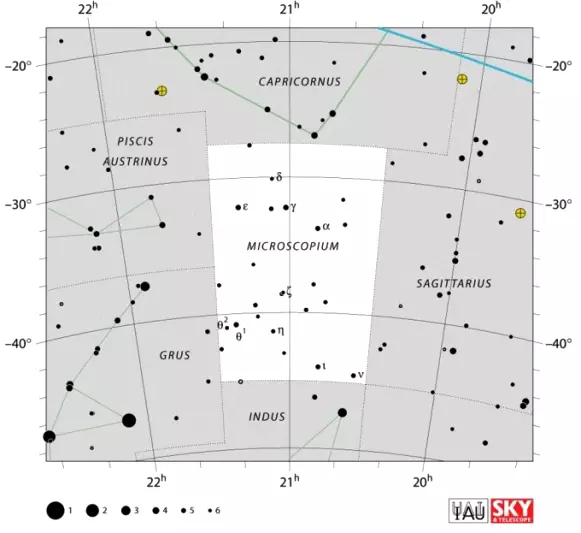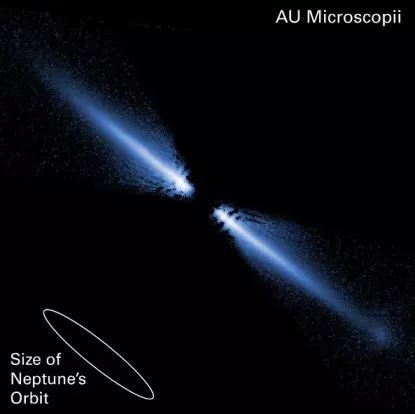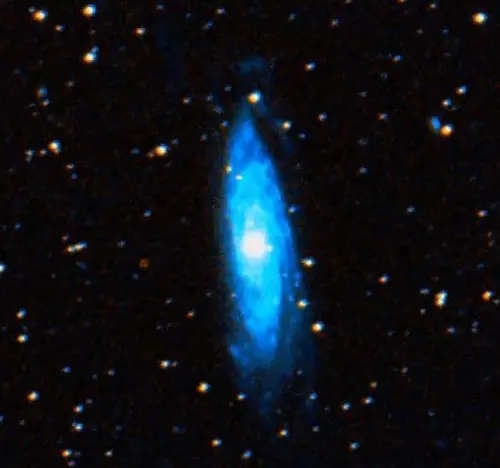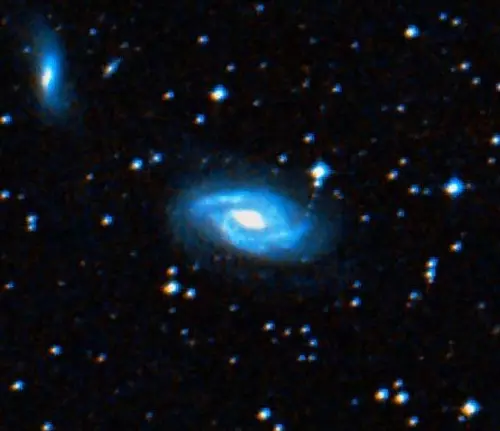Microscopium constellation lies in the southern hemisphere. It represents the microscope and is not associated with any myths.
Microscopium lies to the south of Capricornus, between the constellations Piscis Austrinus and Sagittarius. It is a small, faint constellation that is hard to see from northern latitudes. It was introduced by the French astronomer Nicolas Louis de Lacaille in the 18th century.
The brightest stars in Microscopium are only of fifth magnitude and the constellation cannot be seen without binoculars in less than ideal observing conditions. It does not have any bright deep sky objects.
Facts, location and map
Microscopium is the 66th constellation in size, occupying an area of 210 square degrees. It is located in the fourth quadrant of the southern hemisphere (SQ4) and can be seen at latitudes between +45° and -90°. The neighboring constellations are Capricornus, Grus, Indus, Piscis Austrinus, Sagittarius and Telescopium.
The constellation name Microscopium is pronounced /ˌmaɪkroʊˈskɒpiəm/. In English, the constellation is known as the Microscope. The genitive form of Microscopium, used in star names, is Microscopii (pronunciation: /ˌmaɪkroʊˈskɒpiaɪ/). The three-letter abbreviation, adopted by the International Astronomical Union (IAU) in 1922, is Mic.
Microscopium belongs to the Lacaille family of constellations, along with Antlia, Caelum, Circinus, Fornax, Horologium, Mensa, Norma, Octans, Pictor, Reticulum, Sculptor and Telescopium.
Microscopium contains one star with known planets and has no Messier objects. The brightest star in the constellation is Gamma Micoscopii, with an apparent magnitude of 4.67. There are no meteor showers associated with the constellation.
Microscopium does not contain any formally named stars.

Microscopium constellation map by IAU and Sky&Telescope magazine
Story
Microscopium constellation was created by the French astronomer Nicolas Louis de Lacaille in 1751-1752. Lacaille named it after an early type of compound microscope, one that used more than one lens and was widely used in the 18th century. He described the constellation as depicting “a tube above a square box.”
The official boundaries of the constellation as it is today were set by the Belgian astronomer Eugène Delporte in 1930.
Microscopium stars
γ Microscopii (Gamma Microscopii)
Gamma Microscopii is the brightest star in Microscopium. It has an apparent magnitude of 4.68 and is approximately 229 light years distant from Earth. It is a yellow giant star with the stellar classification of G6 III. It has a visual companion with an apparent magnitude of 13.7 at an angular separation of 26 arc seconds.
Gamma Microscopii has 2.5 times the Sun’s mass, 10 times the solar radius, and is about 64 times more luminous than the Sun.
ε Microscopii (Epsilon Microscopii)
Epsilon Microscopii is the second brightest star in Microscopium. It has a visual magnitude of 4.72 and is approximately 165 light years distant from the solar system. It is a white main sequence dwarf with the stellar classification A1V.
θ Microscopii (Theta Microscopii)
Theta Microscopii consists of a wide double star, Theta-1 Microscopii and Theta-2 Microscopii, which can both be seen without binoculars. Both components belong to the spectral class A and are white magnetic spectrum variable stars that have strong metallic lines.
Theta Microscopii is the third brightest star in the constellation and marks the microscope’s specimen slide. It has an apparent magnitude of 4.81 and is approximately 186 light years distant from the Sun. Theta-1 Microscopii is classified as an Alpha-2 Canum Venaticorum type variable.
α Microscopii (Alpha Microscopii)
Alpha Microscopii is only the fourth brightest star in the constellation. It is a variable star with an apparent magnitude that ranges from 4.88 to 4.94. The star is approximately 380 light years distant from Earth.
Alpha Microscopii is a yellow giant belonging to the stellar class G7III. It has a visual companion with an apparent magnitude of 10 at a separation of 20.4 seconds of arc. The companion can be seen in a small telescope.
Lacaille 8760 (AX Microscopii)
Lacaille 8760 is one of the nearest stars to the Sun. It is only 12.87 light years distant and has an apparent magnitude of 6.67, too faint to be seen without binoculars. It is classified as a flare star and has the variable designation AX Microscopii. The star only erupts less than once a day on average. It has a mass about 60 percent that of the Sun and a radius 0.51 times solar. It is one of the largest and brightest red dwarfs known.
Lacaille 8760 has the stellar classification M0 Ve. It was discovered by Nicolas Louis de Lacaille from the Cape of Good Hope in South Africa in the early 1750s.
The star was closest to the Sun about 20,000 years ago, when it came within 12 light years.
AU Microscopii
AU Microscopii is another variable star in Microscopium. It is a flare star with the stellar classification of M1 Ve. It has an apparent magnitude of 8.73 and is 32.3 light years distant from the solar system. It is too faint to be visible to the unaided eye.
The star has a circumstellar dust disk about 200 astronomical units in radius and is believed to be only 12 million years old. It is a red dwarf with a mass 0.31 times that of the Sun and a radius 0.84 times solar. It has only 9 percent of the Sun’s luminosity.
AU Microscopii is a member of the Beta Pictoris Moving Group of stars.

A visible-light image of a debris disk around the red dwarf star AU Microscopii. Planets may be forming, or might already exist, within it. The disk glows in starlight reflected by tiny grains of dust created by the collisions of asteroids and comets. Because it is composed of the pulverized remnants of these objects, it is called a “debris disk.” More than 40 billion miles across, it appears like a spindle of light because we view it nearly edge on (like looking at a dinner plate along its side). The star is about 12 million years old and is only 32 light-years from Earth. This makes its disk the closest yet seen in reflected starlight. It is also the first disk imaged around an M-type red dwarf, the most common type of star in the stellar neighborhood around the Sun. The Hubble Space Telescope images, taken with the Advanced Camera for Surveys (ACS) reveal that the disk has been cleared of dust within about a billion miles of the star (first indicated from infrared-light measurements). The ACS images confirm that the disk is warped and has small variations in dust density that, along with the central clearing, may be caused by the tugging of an unseen companion, perhaps a large planet. ACS shows that this is the only debris disk known that appears bluer than the star it surrounds. This may indicate that there are more small grains of dust, compared to large ones, than has been seen before in other such disks. Smaller grains scatter blue light better than red. The surplus of small grains may be due to the fact that the star is not bright enough to blow away these tiny particles. In brighter, hotter stars, the pressure from radiation can actually push small dust grains out of the disk and far out into space. Image: NASA/ESA/J.E. Krist (STScI/JPL) & D.R. Ardila (JHU)
BO Microscopii
BO Microscopii is another flare star in Microscopium. It is an orange star with the stellar classification of K3Ve, approximately 170 light years distant from Earth. It has a visual magnitude of 9.39. It has a mass 82 percent that of the Sun and 1.06 times the solar radius.
The star is sometimes called “Speedy Mic” because it is a very fast spinner. It has a projected rotational velocity of 135 km/s and completes a rotation every 0.380 days.
WASP-7 (HD 197286)
WASP-7 is a yellow-white main sequence dwarf with the stellar classification of F5V. It has an apparent magnitude of 9.51 and is approximately 456 light years distant from the solar system. The star can be seen through a small telescope. It has a mass 1.28 times that of the Sun and 1.236 times the Sun’s radius.
An extrasolar planet, WASP-7b, was discovered orbiting the star in 2008. The planet is a hot Jupiter with a mass 0.96 times that of Jupiter and it orbits the star with a period of 4.954658 days.
Deep sky objects in Microscopium
NGC 6925
NGC 6925 is a barred spiral galaxy in Microscopium. It has an apparent magnitude of 11.3. The galaxy is lens-shaped and appears almost edge-on when seen from Earth. It can be found 3.7 degrees to the west-northwest of Alpha Microscopii. It was discovered by the English astronomer John Herschel in July 1834.
A Type IIb supernova, SN 2011ei, was observed in the galaxy in 2011.

NGC 6925, image: Wikisky
NGC 6923
NGC 6923 is another spiral galaxy in Microscopium. It has an apparent magnitude of 12.2 and lies approximately 36.437 million parsecs from Earth. Like NGC 6925, the galaxy was discovered by John Herschel in the summer of 1834.

NGC 6923, image: Wikisky